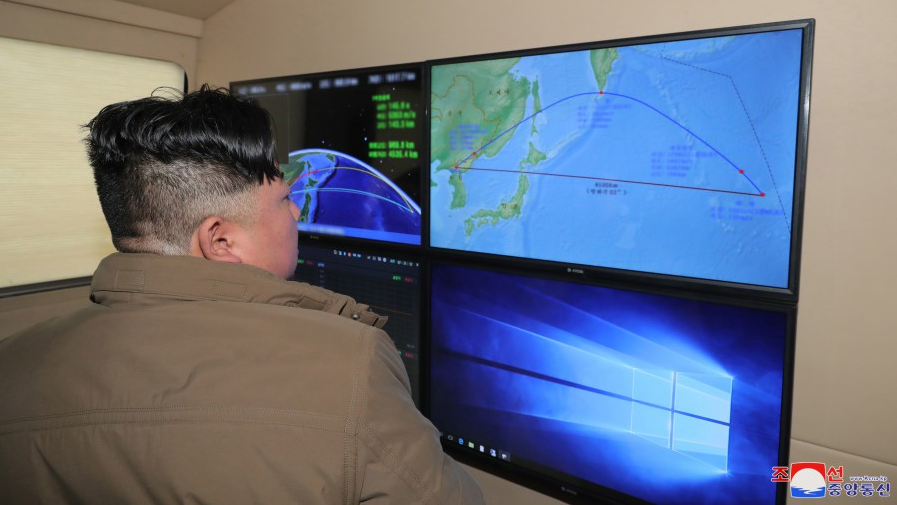
North Korean leader Kim Jong-un observes missile tracking data from the October launch. (DPRK State Media.)
In October, North Korea launched an intercontinental ballistic missile that tracked over Japanese territory. That alone was eye-catching and cause for alarm. Now, expert Ralph Savelsberg of the Netherlands Defence Academy has provided an exclusive analysis to Breaking Defense of his conclusions regarding the capabilities of the weapon — and why the alarm should probably keep ringing.
The large ICBMs displayed by North Korea during military parades, such as the one in Pyongyang last week, always catch a lot of attention. But while there are some hints to capabilities from observing the missiles, the truest test of the DPRK’s missile designs come from live launches. And there is an unfortunate amount of cases to draw from.
Most dramatically, in a test on Oct. 4, an intermediate range ballistic missile overflew Japan, the first time a DPRK launch took such a trajectory since 2017. The missile reportedly flew more than 4,500 km and reached an altitude of 965 km, passing well over Japan before landing in the Pacific Ocean. And as with all North Korean launches, the effort was on to try and identify whether this is a known weapon or a new design.
After carefully studying the data, our conclusion is clear: North Korea has now demonstrated a design that can carry significantly greater payload, at similar or better distances, than its previously demonstrated Hwasong-12.
Initial DPRK silence as to specific claims fueled speculation that the missile used was a Hwasong-12, which was twice launched over Japan in 2017. A few days’ later DPRK state media reported it as a “new-type ground-to-ground intermediate-range ballistic missile” and released images. One showed Kim Jong-Un in front of a bank of monitors, two of which display trajectories.
The Hwasong-12 first flew in May 2017, on a highly lofted trajectory, covering a 787 km range and reaching an altitude of 2,111 km. Based on that trajectory, its estimated maximum range was 4,500 km with an unknown payload. Therefore, it seemed an obvious candidate for the October flight. However, the pictures released a few days later show a significantly different missile.
The images of the missile itself indicate that, while it is similar to the older Hwasong-12 IRBM, it has several new features. Based on the imagery and computer modeling, analysis shows that the missile’s likely performance exceeds that of the Hwasong-12, either increasing the range or payload capacity.
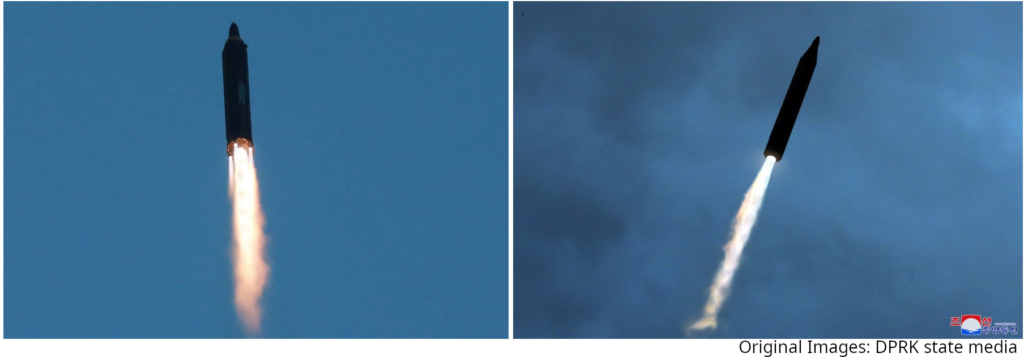
A Hwasong-12 shortly after launch (left) and the new missile launched over Japan on October 4 (right). (DPRK State Media photos)
The Hwasong-12 is powered by the Paektusan engine cluster, with a single main engine surrounded by four Vernier engines used for steering. A single turbopump supplies propellant to the engine and the Verniers. In contrast, the new missile has a single main engine without Vernier motors. There are other differences: the Hwasong-12 has a flared base and a very distinctively shaped “baby-bottle” re-entry vehicle, neither of which are present on the new missile.
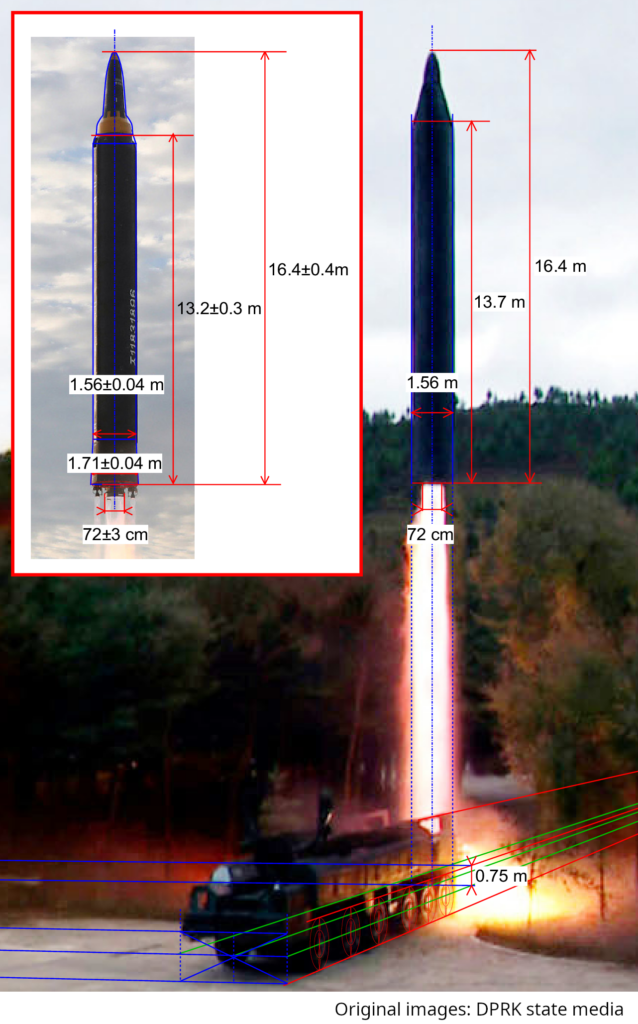
The October 4 missile with size measurements (main image) and the Hwasong-12 in flight (inset), to scale. (DPRK State Media photos; mark-ups by Ralph Salvesberg.)
And yet, there also are similarities. The plume shows the presence of a turbopump exhaust, and an orange oxidizer cloud visible in a launch photograph confirms that it uses liquid propellant, like the Hwasong-12. MAZ-547 Transporter Erector Launcher (TEL) vehicles, used to cart the Hwasong-12 through Pyongyang, enabled measuring the size of the Hwasong-12 and a photograph of the missile in flight provided the diameter of its main engine nozzle. The new missile uses a similar TEL.
The DPRK released just one, low-quality image that shows the complete missile together with its TEL. However, it was still good enough to measure the size of the new missile, with an error margin of less than ten percent. Its diameter and its overall length match the Hwasong-12, but due to its shorter front end, the new missile likely has longer propellant tanks. The error margin in the nozzle diameter is larger, but it too is consistent with the core of the Paektusan engine cluster.
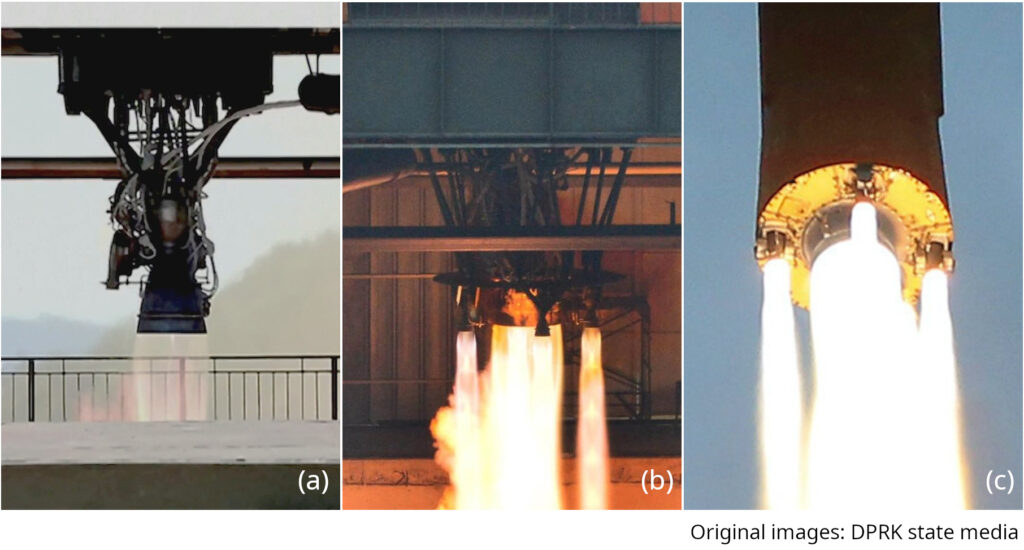
Different configurations of the Paektusan engine cluster: without Vernier engines but with a clearly visible turbopump in September 2016 (a), with four Vernier engines during a static test in September 2017 (b) and in flight on the Hwasong-12. (Original images via DPRK State Media)
All of this suggests that the new missile uses the same engine core as the Hwasong-12 but instead of Vernier engines steering the missile, it may have a gimballed engine. Interestingly, when footage of the Hwasong-12 engine first emerged, back in 2016, it did not have Vernier engines either. A single gimballed nozzle does not provide roll control — a rotation of the missile about the longitudinal axis — so this requires a separate system. (One option could be to vector the small thrust generated by the turbopump exhaust.)
These changes obviously affect performance. Removing the Verniers decreases the thrust; however, this may be compensated by increasing the thrust of the main engine via increased propellant flow. The impact of gravity losses (the effect of having to accelerate the mass of propellant remaining in the tanks for longer) may change depending on whether total thrust is changed. However, since the Vernier engines are less efficient than the main engine, either way, overall efficiency goes up. Furthermore, removing the Vernier engines reduces the empty mass of the missile, although the mass of whatever system that takes over their role partially offsets this.
RELATED: North Korea’s hypersonic missile claims are credible, exclusive analysis shows
So those are the physical parameters of the missile itself. What about performance? To assess the missile’s potential, medium-fidelity computer simulations were done of its trajectory.
Using existing models that replicate the 2017 Hwasong-12 flights, parameters were varied to address the observed changes in the missile configuration. It should be noted that the 3,700 km range on the Hwasong-12’s longest-range flight to date appeared to represent realistic payload capabilities. That range would be sufficient to reach Guam, which is the expected intended target for this type. The take-off accelerations in the simulations closely match accelerations measured in launch videos.
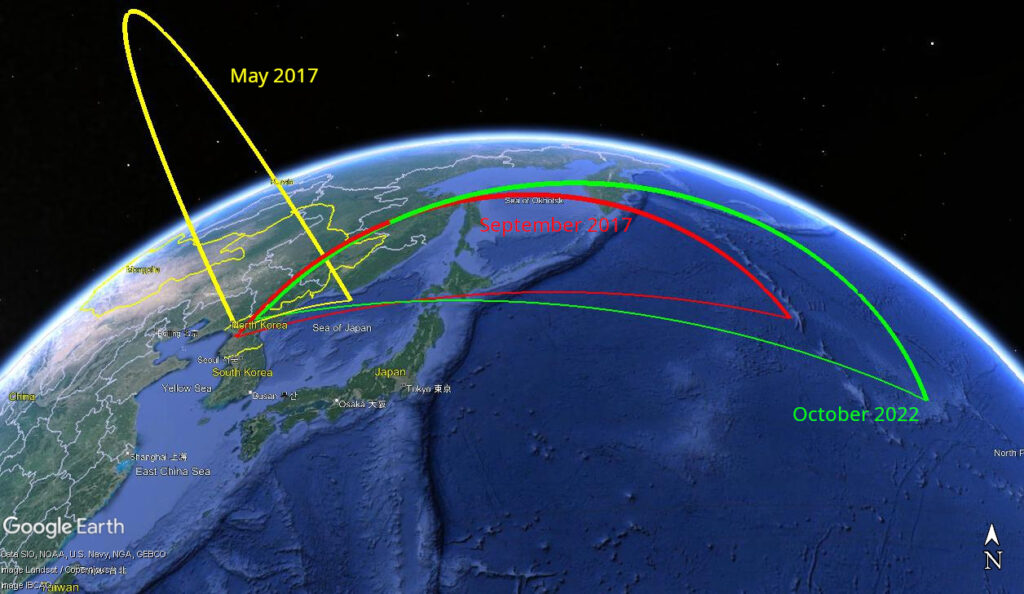
Visualization of the lofted trajectory flown by the Hwasong-12 in May 2017 (yellow), the Japan overflight in September 2017 (red) and the approximate trajectory of the new IRBM flown on October 4, 2022 (green). (Graphic courtesy Ralph Savelsberg)
The Oct. 4 missile likely carries more propellant than the Hwasong-12, has a longer burn time, a slightly higher specific impulse and lower drag, due to the deletion of the flared base. It likely also has a slightly lower deadweight mass fraction, i.e., its booster mass at burnout is a smaller fraction of the booster take-off mass.
The resulting missile model can recreate the trajectory flown on Oct. 4. Incidentally, there is some uncertainty in the exact trajectory. The trajectory to the impact point on Kim Jong-Un’s screen would have taken the missile over Oshima peninsula, north of Tsugaru Strait, which separates Honshu and Hokkaido, whereas Japanese media report that it flew over Aomori Prefecture, south of the Strait. This is a small difference in azimuth from the launch site, which may indicate that the missile’s roll control did not work entirely as intended.

Range as a function of the payload, for both missiles, without Earth rotation (dashed lines) and on a heading from the DPRK towards Guam (solid lines). (Courtesy Ralph Savelsberg)
The simulations show that the new missile can plausibly deliver a significantly heavier warhead over similar distances than the Hwasong-12. Specifically, the range from the DPRK to Guam is about 3,500 km. The Hwasong-12 can deliver a payload (including its heat shield) of 950 kg to that distance, while the equivalent for the new missile is about 1,200 kg. In fact, the simulations suggest that the missile is optimized for that performance, since for a lighter warhead and a longer range, a missile with less propellant would be optimal.
Put another way: if our simulations are correct, North Korea’s October launch demonstrated the ability to deliver an almost 20 percent greater payload into the heart of America’s key military base in the Pacific.
Ralph Savelsberg, a member of the Breaking Defense Board of Contributors, is associate professor at the Netherlands Defence Academy in Den Helder, the Netherlands, specializing in missile defense. This article does not reflect any official position or policy of the Government of the Netherlands. The author would like to thank James Kiessling and Tomohiko Kawaguchi for their valuable comments on the manuscript.






















